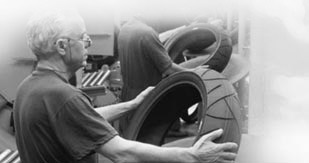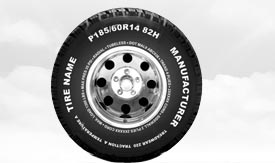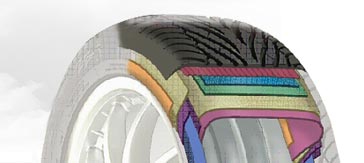
Tyre Knowledge
Components of a Tyre
A tire carcass is composed of several parts.
Tread
The tread is that part of the tyre which comes in
contact with the road. The tread is made of thick rubber, or composite
compound formulated to provide an appropriate level of traction that does
not wear away quickly. Tire tread patterns are the arrangement of continuous
ribs, independent tread blocks, circumferential and lateral grooves, as well
as the thin sipes molded into the tread to fine-tune noise, handling,
traction and wear. Tire treads patterns feature different basic designs to
help them meet anticipated driving conditions.
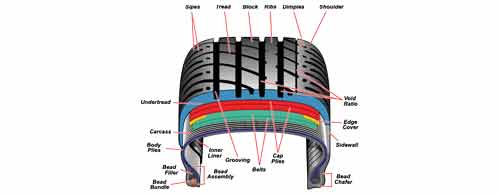
 Click
here to enlarge view
Click
here to enlarge view
Bead
The bead is that part of the tire that contacts the rim on
the wheel. The bead is typically reinforced with steel wire and compounded
of high strength, low flexibility rubber. The bead seats tightly against the
two rims on the wheel to ensure that a tubeless tire holds air without
leakage. The bead fit is tight to ensure the tire does not shift
circumferentially as the wheel rotates. The width of the rim in relationship
to the tire is a factor in the handling characteristics of an automobile,
because the rim supports the tire's profile.
Sidewall
The sidewall is that part of the tire that bridges
between the tread and bead. The sidewall is largely rubber but reinforced
with fabric or steel cords that provide for strength and flexibility. The
sidewall transmits the torque applied by the drive axle to the tread in
order to create traction. The sidewall, in conjunction with the air
inflation, also supports the load of the vehicle. Sidewalls are molded with
manufacturer-specific detail, government mandated warning labels, and other
consumer information.
Shoulder
The shoulder is that part of the tire at the edge
of the tread as it makes transition to the sidewall.
Ply
Plies are layers of relatively inextensible cords
embedded in the rubber to hold its shape by preventing the rubber from
stretching in response to the internal pressure. The orientations of the
plies plays a large role in the performance of the tire and is one of the
main ways that tires are categorized. The number of plies determines the
load capacity of the tyre.
Construction Types
Bias
Bias tire (or cross ply) construction utilizes body ply cords
that extend diagonally from bead to bead, usually at angles in the range of
30 to 40 degrees, with successive plies laid at opposing angles forming a
crisscross pattern to which the tread is applied. The design allows the
entire tire body to flex easily, providing the main advantage of this
construction, a smooth ride on rough surfaces. This cushioning
characteristic also causes the major disadvantages of a bias tire: increased
rolling resistance and less control and traction at higher speeds.
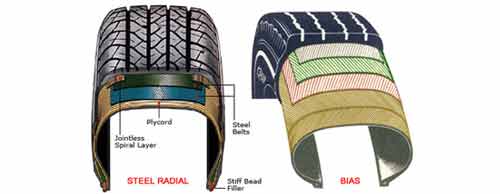
 Click
here to enlarge view
Click
here to enlarge view
Belted Bias
A belted bias tire starts with two or more bias-plies to
which stabilizer belts are bonded directly beneath the tread. This
construction provides smoother ride that is similar to the bias tire, while
lessening rolling resistance because the belts increase tread stiffness. The
plies and belts are at different angles, which improves performance compared
to non-belted bias tires. The belts may be cord or steel.
Radial
Radial tire construction utilizes body ply cords extending from the beads
and across the tread so that the cords are laid at approximately right
angles to the centerline of the tread, and parallel to each other, as well
as stabilizer belts directly beneath the tread. The belts may be cord or
steel. The advantages of this construction include longer tread life, better
steering control, and lower rolling resistance. Disadvantages of the radial
tire include a harder ride at low speeds on rough roads and in the context
of off-roading, decreased "self-cleaning" ability and lower grip
ability at low speeds.
Solid
Many tires used in industrial and commercial applications are
non-pneumatic, and are manufactured from solid rubber and plastic compounds
via molding operations.
Solid tires include those used for
lawn mowers, skateboards, golf carts, scooters, and many types of light
industrial vehicles, carts, and trailers. One of the most common
applications for solid tires is for material handling equipment (forklifts).
Such tires are installed by means of a hydraulic tire press.
Specifications
Tire pressure monitoring system
Tire pressure monitoring systems (TPMS) are electronic systems that monitor
the tire pressures on individual wheels on a vehicle, and alert the driver
when the pressure goes below a warning limit. There are several types of
designs to monitor tire pressure. Some actually measure the air pressure,
and some make indirect measurements, such as gauging when the relative size
of the tire changes due to lower air pressure.
Inflation pressure
Tires are specified by the vehicle manufacturer with a recommended
inflation pressure, which permits safe operation within the specified load
rating and vehicle loading. Most tires are stamped with a maximum pressure
rating. For passenger vehicles and light trucks, the tires should be
inflated to what the vehicle manufacturer recommends, which is usually
located on a decal just inside the driver's door or in the vehicle owners
handbook. Tires should not generally be inflated to the pressure on the
sidewall; this is the maximum pressure, rather than the recommended
pressure.
Load rating
Tires are specified by the manufacturer with a maximum load rating. Loads
exceeding the rating can result in unsafe conditions that can lead to
steering instability and even rupture.
Speed rating
The speed rating denotes the maximum speed at which a tire is designed to
be operated. For passenger vehicles these ratings range from 99 to 186 miles
per hour (159 to 299 km/h). Replacing a tire on a vehicle with one with a
lower speed rating than originally specified by the vehicle manufacturer may
render the insurance invalid.
Retread
Tires that are fully worn can be re-manufactured to replace the worn tread.
This is known as retreading or recapping, a process of buffing away the worn
tread and applying a new tread. Retreading is economical for truck tires
because the cost of replacing the tread is less than the price of a new
tire. Retreading passenger tires is less economical because the cost of
retreading is high compared to the price of new cheap tires, but favorable
compared to high-end brands.
Markings
DOT code
In the United States, the DOT Code is an alphanumeric character
sequence molded into the sidewall of the tire for purposes of tire
identification. The DOT Code is mandated by the U.S. Department of
Transportation. The DOT Code is useful in identifying tires in a product
recall.
E-mark
All tires sold for road use in Europe after July 1997 must carry an E-mark.
The mark itself is either an upper case "E" or lower case "e" -
followed by a number in a circle or rectangle, followed by a further number.
An (upper case) "E" indicates that the tire is certified to comply
with the dimensional, performance and marking requirements of ECE regulation
30. A (lower case) "e" indicates that the tire is certified to
comply with the dimensional, performance and marking requirements of
Directive 92/23/EEC.
Safety
Proper vehicle safety requires specific attention to inflation pressure,
tread depth, and general condition of the tires. Over-inflated tires run the
risk of explosive decompression (they may pop). On the other hand,
under-inflated tires have a higher rolling resistance and suffer from
overheating and rapid tread wear particularly on the edges of the tread.
Excessive tire wear will reduce steering and braking response, and
tires worn down past their safety margins and into the casing run the very
real risk of rupturing.
Hydroplaning (or aquaplaning)
Hydroplaning, also known as aquaplaning, is the condition where a layer of
water builds up between the tire and road surface. Hydroplaning occurs when
the tread pattern cannot channel away enough water at an adequate rate to
ensure a semi-dry footprint area. When hydroplaning occurs, the tire
effectively "floats" above the road surface on a cushion of water -
and loses traction, braking and steering, creating a very unsafe driving
condition. When hydroplaning occurs, there is considerably less
responsiveness of the steering wheel. The correction of this unsafe
condition is to gradually reduce speed, by merely lifting off the
accelerator/gas pedal.
Scrap tires and environmental issues
Once tires are discarded, they are considered scrap tires. Scrap tires
are often re-used for things from bumper car barriers to weights to hold
down tarps. Some facilities are permitted to recycle scrap tires through
chipping, and processing into new products, or selling the material to
licensed power plants for fuel. Some tires may also be retreaded for re-use.
One group did "a study to evaluate the possibility of using scrap tires
as a crash cushion system. The objective of this study was to evaluate the
material properties of used tires and recycled tire-derived materials for
use in low-cost, reusable crash cushions".
